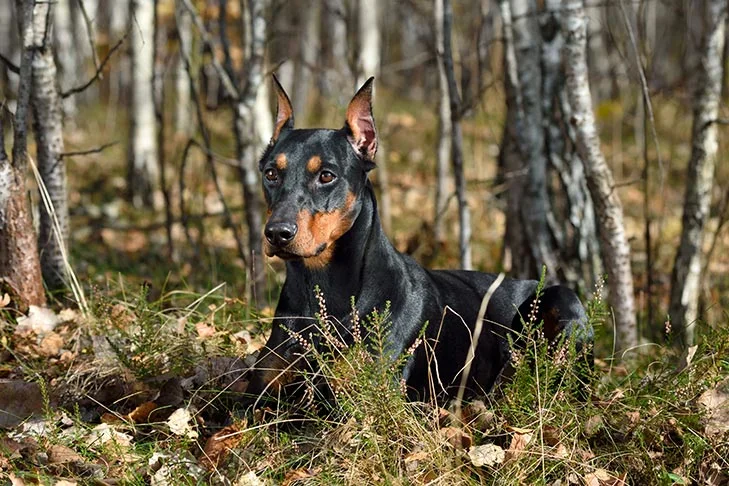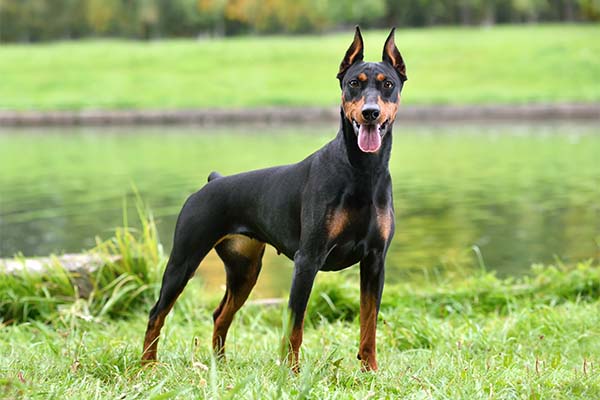German Pinscher
intelligent / courageous / vivacious
Average sizes and life
expectancy of the breed.
Height
17-20 inches
Weight
25-45 pounds
Life Expectancy
12-14 years
Breed Traits & Characteristics
About the Breed
One of Germany’s oldest breeds and the model for all pinscher breeds is the sleek, unfussy German Pinscher. Although originally bred to trap rats, this highly clever, active dog is capable of being trained for all kinds of canine activity.
A genuine dog lover’s joy, GPs are sleek, glossy, and streamlined. Although they are attractive and graceful, dogs aren’t overly fussy or extravagant in any way. They will be roughly the height of an adult’s knee. Under a shimmering crimson, black, or blue coat with red accents, muscles tremble. The skull is large and wedge-shaped, and the dark eyes are watchful and eager. GPs move with the kind of sturdy, smooth gait that conveys that this is a self-assured companion, ready for whatever the day may bring.

What To Expect When Caring For a German Pinscher
Owning a dog is not just a privilege; it’s a responsibility. They depend on us for, at minimum, food and shelter, and deserve much more. When you take a dog into your life, you need to understand the commitment that dog ownership entails.
 Health
Health
German Pinschers are normally strong, healthy dogs, however, the breed is susceptible to a few diseases. These include von Willebrand's illness, eye disease, and hip dysplasia. Within the breed, there is a very low frequency of heart issues, and some delayed post-vaccination difficulties have also been observed. Responsible breeders examine all breeding stock for ailments that can harm the breed. Use toothpaste made for dogs to brush their teeth frequently. Regular visits to the vet for checks and parasite management are recommended to ensure the dog has a long and healthy life.
Recommended Health Tests From the National Breed Club:
- Hip Evaluation
- Von Willebrand's Disease DNA Test
- Cardiac Exam
- Ophthalmologist Evaluation
 Grooming
Grooming
The short, thick coat of the German Pinscher requires little upkeep. He will stay shiny and look his finest with weekly brushing and the occasional wash. As with all breeds, if not naturally worn down, his nails should be clipped every month because excessively long nails can be unpleasant and make it difficult to run and walk. Every week, his ears should be examined for debris and extra wax, and cleansed if necessary.
 Exercise
Exercise
The German Pinscher is an athletic, high-energy breed that demands daily activity in sufficient amounts for both its physical and mental health. The breed has a high prey drive and is robust and medium in size. They are excellent companions and performing dogs because of their alertness and intelligence. Anything that tests their impressive physical and mental prowess, including canine sports like obedience, agility, rally, tracking, and barn hunts, they thrive.
 Training
Training
German Pinschers are extremely bright—so intelligent that they have the potential to be cunning. They demand a firm and knowledgeable owner, particularly one who has prior working dog experience. This playful, willful breed needs a lot of early socialization and obedience instruction. The biggest difficulty is maintaining the German Pinscher's interest and involvement. He is a high-energy dog who is perceptive of his environment, curious, and willing to explore new things. They are not the best breed for first-time dog owners.
 Nutrition
Nutrition
German Pinschers should be fed premium dog food that is suitable for their age (puppy, adult, or senior) and level of activity. Treats can be a valuable training tool, but offering them in excess might lead to obesity. Discover which foods fit the bill for canine consumption and which don't. If you have any queries or worries regarding your dog's weight or diet, speak to your veterinarian or the breeder. Fresh, clean water must always be accessible.
History
The German Pinscher is one of the oldest breeds in its own country. It can be considered that this German breed is the ancestor of the Miniature Pinscher and the perennially well-liked Doberman. (A helpful historian explains that “‘pinscher’ appears to be a Germanic form of the French word ‘pincer,’ meaning to seize or to nip.”) And seizing and nipping are appropriate descriptors of how German Pinschers once made a living: by killing rats. They make great watchdogs and watchful family protectors nowadays.



